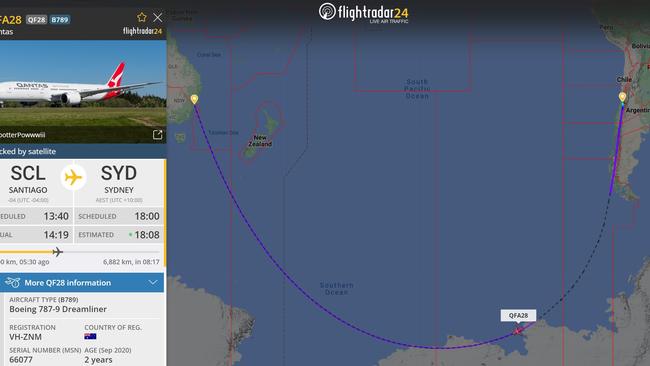Why a Qantas flight took passengers to the bottom of the earth en route from Santiago
Pilots of the usual ‘straight-line’ flight from Santiago to Sydney were forced to make a drastic diversion due to strong headwinds.
Flightradar images have revealed how a Qantas flight from Santiago to Sydney took passengers to the bottom of the earth in an effort to avoid strong headwinds.
The flight normally followed a relatively straight line across the Pacific Ocean but conditions on the July 14 service saw pilots take a drastic diversion.
Despite the unusual route, the flight time was only a few minutes longer than the average for the route at 14-hours and 1-minute, compared to 13-hours and 57-minutes.
It was not the first time flight QF28 had taken such a route, with travellers sharing pictures to social media of a previous foray over Antarctica in November 2016.
On this occasion, passengers were not treated to such a spectacular view of the icy continent because it was dark.
Qantas confirmed strong headwinds prompted the diversion, and pointed out weather often took the airline to unusual places but that was factored into the flight plan.
Qantas international pilots are no strangers to Antarctic airspace, with the airline operating regular charter flights over the region in the summer, to give passengers a good look.
The flying kangaroo also made several hops over Antarctica in 2021, during the longest ever commercial flight operated by Qantas, from Buenos Aires to Darwin.
QF28 November 2016 pic.twitter.com/w3cllZK2fI
— Jhumblej (@jhamblej) July 17, 2023
Flightradar director of communications Ian Petchenik said Qantas Boeing 787-9s were certified to operate as far as five-hours and 30-minutes from the nearest airfield, due to their ETOPS 330 rating.
ETOPS or extended range, twin operations performance standards were introduced in 1985 to allow twin-engine aircraft to fly across large bodies of water.
The time allocated is based on an aircraft’s ability to fly on just one engine without damaging the aircraft.

Prior to the introduction of ETOPS, twin-engine aircraft could only operate within an hour of the nearest airfield, forcing airlines to use four-engine aeroplanes on trans-Pacific or trans-Atlantic flights.
The first ETOPS rating of 120-minutes (2-hours) was given to a Boeing 767 operated by Trans World Airlines.
In 2023, Airbus A350s have the longest ETOPS rating of 370-minutes or 6-hours and ten-minutes.
Qantas has 12 A350-1000s on order to operate its Project Sunrise flights from Australia’s east coast to destinations such as New York and London, starting in late 2026 or 2027.







To join the conversation, please log in. Don't have an account? Register
Join the conversation, you are commenting as Logout